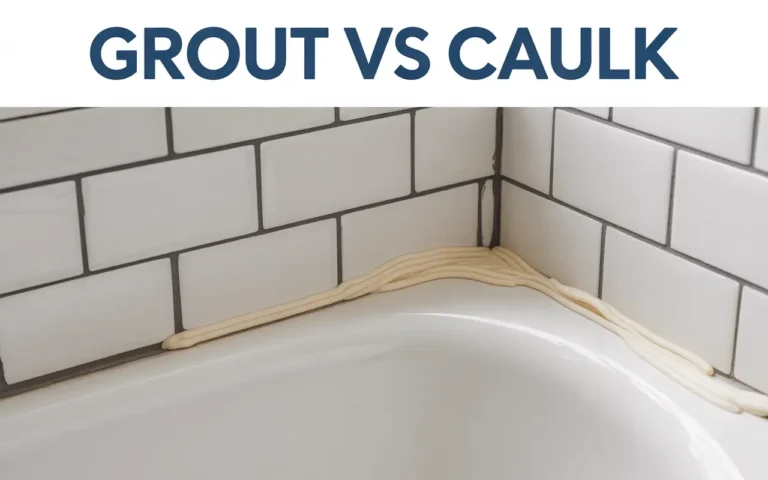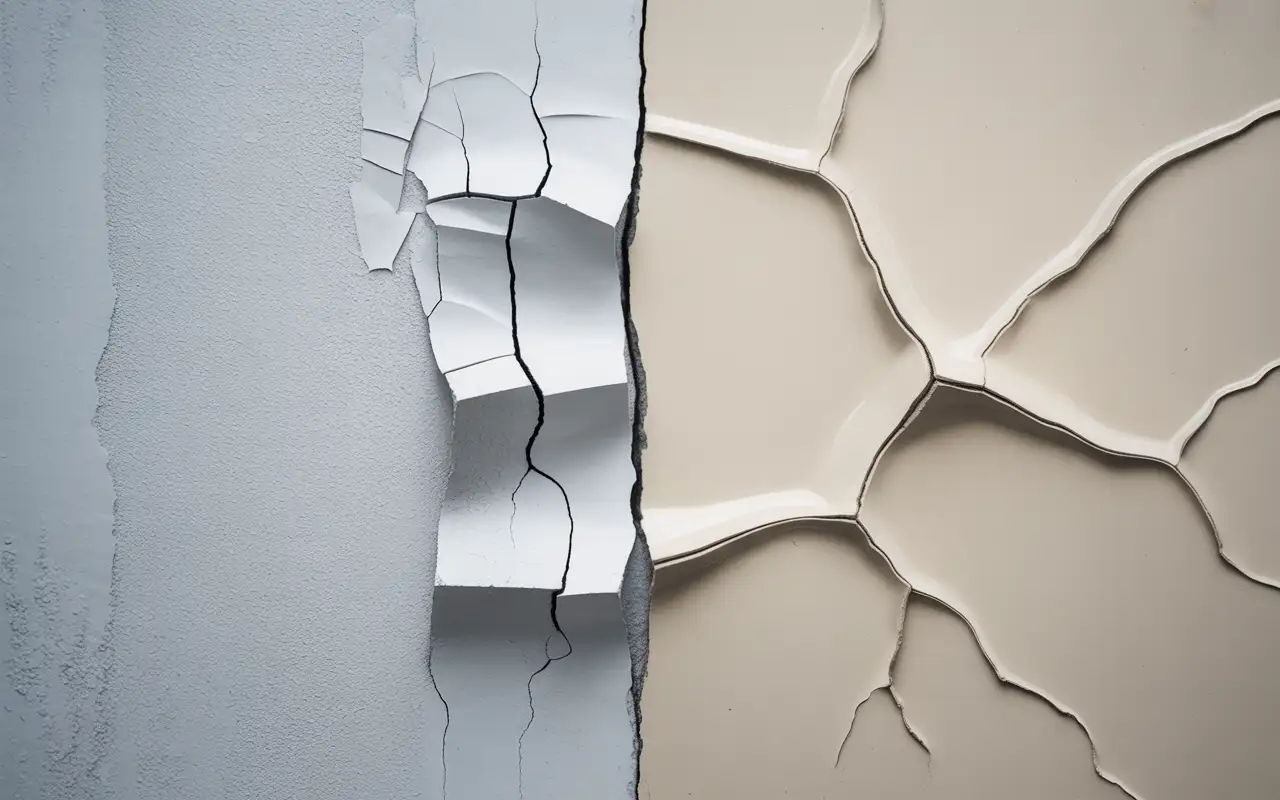Walk into any bathroom or kitchen, and you’ll see two materials working together to keep water where it belongs. Understanding grout vs caulk is essential for any homeowner tackling tile work or bathroom repairs. These materials look similar but serve completely different purposes, and using the wrong one can lead to cracked tiles, water damage, and expensive repairs.
Grout fills the spaces between tiles to secure their position with a cement-based bond, while caulk can seal joints and corners with a flexible, waterproof material that moves with your home. Knowing when to utilize each one will save you money and protect your investment.
Table of Contents
ToggleWhat Is Grout?
Grout is a powder made of cement, sand, and water that hardens into an impenetrable surface when mixed. Grout plays an integral role in holding tiles together on floors or shower walls by bonding to the substrate beneath and providing an impenetrable barrier that prevents water from reaching behind your tiles.
Types of Grout
- Sanded Grout costs less and works best for gaps wider than 1/8 inch. The sand particles give it strength and prevent shrinking. You’ll find this in most floor installations and areas with heavy foot traffic. It stands up to pressure without cracking.
- Unsanded Grout creates a smooth finish perfect for delicate tiles like marble or glass tile. It costs about twice as much as sanded grout but won’t scratch polished surfaces. Use this for wall tiles and gaps smaller than 1/8 inch. The downside? It can crack under pressure, so skip it for floors.
- Epoxy Grout mixes resin and hardener instead of cement. This type resists stains, moisture, and chemicals better than cement-based options. Restaurants and commercial kitchens use it because it lasts decades without sealing. The price runs higher, but you’ll never need to reseal it.
How Grout Works
Grout starts as a powder in a bag. You mix it with water to create a thick paste, then spread it over your tiles at a 45-degree angle using a tool called a float. The mixture fills every gap and bonds to the tile edges. After 15 minutes, you wipe away excess material with a damp sponge.
The real magic happens during curing. As water evaporates, grout transforms into a concrete-like material that locks tiles in place. This takes 24 hours for light traffic and up to 72 hours for full strength. The hard surface prevents tile movement and protects edges from chipping.
Grout Limitations
Cement-based grout is porous, meaning it absorbs liquids such as water, soap and dirt like a sponge, leading to staining and discolouration over time. Darker-coloured grout usually hides stains better, but all varieties require regular cleaning and resealing every 1-2 years for best results.
Grout cannot accommodate movement; when surfaces expand and contract, rigid grout cracks and fails. That is why you won’t see grout where tile meets the bathtub or where corners join two walls; these joints need flexible caulking solutions instead.
What Is Caulk?
Caulk is a thick, flexible sealant made from silicone, acrylic, or latex. It comes ready to use in tubes and stays soft enough to move with your home’s natural shifts. While grout bonds tiles together, caulk creates waterproof seals in gaps that experience movement.
Types of Caulk
- Silicone Caulk offers the best water resistance for wet areas. It bonds to glass, tile, and metal without breaking down. Bathrooms and kitchens need this type around tubs, showers, and sinks. The catch? You can’t paint over pure silicone, and it costs more than other options.
- Acrylic Latex Caulk works for dry areas and accepts paint. Painters use this around baseboards, trim, and moldings before finishing work. It dries fast and cleans up with water. But it’s not waterproof, so keep it away from showers and tubs.
- Acrylic Latex Silicone Caulk blends both formulas. You get some water resistance plus the ability to paint over it. This hybrid works for interior and exterior projects where you need both features. It costs less than pure silicone while offering better protection than basic acrylic.
How Caulk Works
Cut the tube tip at a 45-degree angle, load it in a caulk gun, and squeeze out a smooth bead. The material fills gaps and sticks to both surfaces. Unlike grout, caulk doesn’t need mixing or special tools. A wet finger or smoothing tool shapes the bead and pushes it deep into the joint.
Caulk cures by releasing solvents into the air. Most types skin over in 30 minutes but need 24 hours before getting wet. Full cure takes 3-5 days. Even after curing, quality caulk stays flexible for 5-20 years, depending on the formula and conditions.
Caulk in Home Improvement
Beyond tile work, caulk seals gaps around windows and doors to stop drafts. It fills cracks in walls before painting. Contractors use it to secure loose carpet edges, reattach separated wallpaper, and seal pest entry points. A tube of silicone caulk handles dozens of quick fixes around your home.
Grout vs Caulk: Key Differences

The difference between grout and caulk comes down to flexibility and application. These materials aren’t interchangeable, even though they often work side by side in the same room.
Material Composition
Grout mixes cement powder with sand and water. Some formulas add polymers for extra strength. The mixture hardens through a chemical reaction as water evaporates. Think of it like concrete on a small scale.
Caulk on the other hand uses rubber-like compounds that stay pliable. Silicone, acrylic, and latex bases keep the material soft enough to stretch and compress. No mixing required since it comes ready to apply.
Flexibility and Movement
Grout becomes rigid and unmovable. This strength holds tiles firmly in place but means it cracks when surfaces shift. Temperature changes, house settling, and vibration all cause movement that grout can’t handle.
Caulk stays flexible and waterproof for years. It stretches and compresses with expansion and contraction. When your tub heats up from hot water, the caulk moves with it. When winter cold contracts your window frames, caulk maintains its seal.
Application Areas
Use grout between tiles on floors, walls, and backsplashes. The rigid bond prevents tiles from shifting and protects the substrate underneath. Grout joints typically range from 1/16 inch to 1/2 inch wide.
Use caulk where different materials meet or in corners. The space between tile and tub needs caulk. Shower corners need caulk. Anywhere two surfaces move independently requires caulk’s flexibility. These joints handle constant moisture and temperature swings.
Cost Comparison
Sanded grout costs $8-15 for a 10-pound bag that covers about 50 square feet. Unsanded grout runs $12-20 per bag with similar coverage. Epoxy grout jumps to $40-80 per bag but never needs sealing.
Caulk tubes cost $3-8 each and cover about 30 linear feet. Silicone runs $5-12 per tube. For a standard bathroom, expect to spend $15-30 on grout and $10-20 on caulk for a complete tile project.
Professional installation adds $3-8 per square foot for grouting and $1-3 per linear foot for caulking. A 100-square-foot bathroom costs $300-800 for grout work and $50-150 for caulk application.
Maintenance Needs
Grout requires sealing every 1-2 years to prevent staining. Clean it monthly with pH-neutral cleaners. Harsh chemicals break down the cement and cause deterioration. Deep stains need professional cleaning or grout replacement.
Caulk needs inspection twice yearly. Look for shrinking, cracking, or mold growth. When caulk fails, scrape it out completely and apply fresh material. Most homeowners replace bathroom caulk every 3-5 years as part of regular upkeep.
How Grout and Caulk Are Stored
Storage affects how long these materials last and how well they perform. Proper handling saves money and ensures quality results.
Storing Grout
Grout powder stays good for years in a sealed bag kept dry. Store bags off the floor in a cool, dry space. Moisture in the air can start the curing process prematurely, turning your powder into lumps.
Once mixed, grout has a working time of 30-90 minutes before it becomes too stiff to use. You can’t save leftover mixed grout. Plan your quantities carefully to avoid waste. A 10-pound bag covers about 50 square feet at typical joint widths.
Storing Caulk
Sealed caulk tubes last 1-2 years on the shelf. Check the date code before buying. Once opened, the caulk dries out quickly. Some types stay usable for weeks if you seal the tip with a nail or screw, but many harden within days.
Extreme temperatures ruin caulk. Don’t store it in hot garages or cold sheds. Room temperature storage keeps the material workable. If the caulk becomes thick and hard to squeeze, throw it out and buy fresh.
Using Grout and Caulk Together: Things to Keep In Mind
Most tile projects need both materials working in harmony. Understanding where each belongs prevents common mistakes that lead to water damage.
The Right Material in the Right Place
Apply grout between all fixed tiles on walls and floors. The rigid bond creates a unified, tiled surface that resists water penetration. Grout lines typically run 1/8 to 1/4 inch wide for wall tiles and 1/4 to 3/8 inch for floor tiles.
Switch to caulk at change of plane areas. This includes corners where walls meet, edges where tile meets a tub, and perimeters around sinks. These joints experience movement that would crack grout within months.
Never Caulk Over Grout
Some homeowners try sealing grout with caulk to add water resistance. This traps moisture underneath and creates perfect conditions for mold and mildew. Grout needs to breathe and dry out between uses.
Caulk also hides grout’s decorative element. Colored grout adds visual interest to tile work. Covering it with translucent caulk looks messy and defeats the design purpose.
Timing Matters
Let grout cure completely before caulking adjacent areas. Most grouts need 24-72 hours to reach full strength. Caulking too soon can introduce moisture that weakens the grout bond and delays proper curing.
Clean all surfaces before applying either material. Dust, soap residue, and old caulk prevent proper adhesion. Use rubbing alcohol on areas you’ll caulk and water for areas you’ll grout.
Color Matching
Many manufacturers make caulk colors that match popular grout shades. This creates a seamless look between grouted tiles and caulked corners. Bring a grout sample to the store or note the exact color name when shopping for tile caulk.
Keep leftover grout and caulk labeled with the project location. Future repairs will match perfectly when you use the same batch numbers and color codes.
When to DIY and When to Call a Professional
Simple tile repairs and small caulking jobs make good DIY projects. Larger installations and problem areas need experienced hands.
Good DIY Projects
Recaulking a tub or sink takes 1-2 hours and costs under $20 in materials. You’ll need a utility knife, caulk gun, and silicone caulk. Scrape out old material, clean with alcohol, and apply a fresh bead. Even beginners get decent results on their first try.
Grouting small areas like a kitchen backsplash works for patient DIYers. A 20-square-foot backsplash needs about 3 hours and $30-50 in materials and tools. Watch tutorial videos and practice on scrap tiles first.
When to Call Professionals
Full bathroom remodels involve precise tile layout, waterproofing membranes, and proper substrate preparation. One mistake leads to water damage behind your walls. General contractors in San Diego charge $50-100 per hour but prevent expensive failures.
Large format tiles require perfectly flat surfaces and special thin-set mortar. The grout lines must stay consistent across the entire installation. Professional tools and years of experience make the difference between a good job and a great one.
Shower pan installations absolutely need professional expertise. Incorrect slope or failed waterproofing creates hidden leaks that destroy floor joists and subfloors. The repair costs far exceed the installation savings.
San Diego Custom Painting handles complete bathroom and kitchen tile work with proper waterproofing and lasting results. Our team has 27+ years installing tile in coastal climates where moisture challenges every seal and bond. We guarantee our grout and caulking work for two years and use only epoxy grout in wet areas for maximum durability. Contact us today for a free estimate on your tile project.
Final Thoughts
The choice between grout versus caulk isn’t really a choice at all. Both materials serve specific purposes, and successful tile work requires using each one correctly. Grout provides the rigid structure that keeps tiles in place and creates durable surfaces. Caulk offers the flexibility needed to seal moving joints and prevent water damage.
The wrong material in the wrong position is the most common cause of tile failures. There are cracks in the grout around the corners. Caulk doesn’t work between tiles. A basic rule of “grout for tile-to-tile, caulk for tile-to-other” prevents 90% of frequent problems.
Both materials will last longer if you take care of them regularly. Check your caulk twice a year and seal your grout once a year. Fix problems right away. Fixing small issues today stops big fixes from happening tomorrow.
FAQs About Grout vs Caulk
Can you use caulk instead of grout between tiles?
No. Caulk lacks the strength to hold tiles in place and will shrink over time. It doesn’t bond to the substrate like grout does. While caulk might look acceptable for a few months, it will eventually fail, allowing water behind the tiles and causing them to loosen. Always use proper grout between tiles and save caulk for corners and expansion joints.
Should you grout or caulk between tile and tub?
Always use caulk between tile and tub. The tub expands when filled with hot water and contracts when empty. This constant movement would crack rigid grout within weeks. Silicone caulk flexes with these changes while maintaining a waterproof seal. Color-match your caulk to your grout for a seamless appearance.
What is the best shower tile sealant?
100% silicone caulk provides the best water resistance for shower corners and edges. For grout lines, use a penetrating grout sealer every 1-2 years. Epoxy grout eliminates the need for sealers entirely since it’s naturally waterproof and stain-resistant. In shower corners specifically, always choose silicone over acrylic for maximum mold resistance.
How long does grout and caulking last?
Properly sealed grout lasts 10-20 years with regular maintenance. Epoxy grout can last 30+ years without sealing. Caulk typically needs replacement every 5-10 years depending on conditions. Bathroom caulk in constant contact with water may only last 3-5 years. Regular inspection helps you catch failures before water damage occurs.
Can you put a new caulk over the old caulk?
Never apply new caulk over old. The new layer won’t bond properly and will peel away quickly. Always remove and replace all old caulk completely. Scrape out every bit with a utility knife or caulk removal tool, clean the joint with rubbing alcohol, let it dry completely, then apply fresh material. This ensures proper adhesion and a lasting seal.
Is grout or caulk more waterproof?
Caulk is more waterproof than standard cement-based grout. Unsealed grout is porous and absorbs water readily. Even sealed grout eventually allows some moisture penetration. Silicone caulk creates a completely waterproof barrier that water cannot penetrate. This makes caulk essential for areas with direct water exposure like tub edges and shower corners.
Should you caulk around the tub or grout?
Always caulk around the tub. The joint where tile meets the tub experiences constant movement and water exposure. Grout would crack within weeks from the tub’s expansion and contraction. Use 100% silicone caulk designed for kitchen and bath applications. Apply it in a continuous bead with no gaps to prevent water from seeping behind the tub.
What’s the difference between grout and caulk?
Grout is a rigid, cement-based material that fills spaces between tiles and bonds them together. Caulk is a flexible sealant that stays soft enough to move with expansion and contraction. Use grout between tiles for strength and stability. Use caulk in corners and joints that experience movement. They work together but serve completely different purposes in tile installations.





